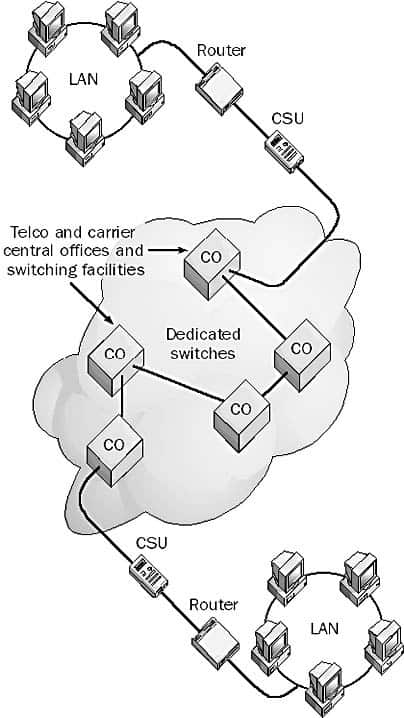In the vast and complex world of computer networking, understanding the mechanisms that facilitate efficient and reliable data transmission is crucial. One such mechanism, the Permanent Virtual Circuit (PVC), stands as a cornerstone in the architecture of modern telecommunications.
This article embarks on an exploratory journey into the realm of PVCs, shedding light on their operational essence, significance, and comparative advantages. From the foundational concepts to intricate technicalities, we aim to provide a comprehensive guide that not only educates but also engages our readers in the fascinating dynamics of network technology.
Index:
- What is a Permanent Virtual Circuit (PVC)?
- How Does a PVC Work?
- Benefits of Using PVCs in Networking
- PVCs vs. Switched Virtual Circuits (SVCs): A Comparative Analysis
- Applications of Permanent Virtual Circuits
- Setting Up a PVC: A Step-by-Step Guide
- Challenges and Considerations in Implementing PVCs
- Future Perspectives on PVCs in Networking
- Conclusion
- References
- Video

1. What is a Permanent Virtual Circuit (PVC)?
A Permanent Virtual Circuit (PVC) is a fixed data transmission path that is established between two or more points in a network. Unlike physical circuits, which are tangible and dedicated lines, PVCs are virtual – meaning they utilize shared network resources to simulate a private, dedicated path for data flow. This virtualization allows for efficient use of network infrastructure, making PVCs a preferred choice for many organizations.
Fundamentally, PVCs are used in packet-switched networks, such as Frame Relay, Asynchronous Transfer Mode (ATM), and X.25 protocols. In these environments, data is transmitted through packets, which travel across a network taking the path of least resistance. PVCs streamline this process by establishing a pre-defined route for these packets, thereby enhancing the reliability, speed, and security of the data transmission.
Operating on the principle of permanence, these circuits do not require setup and teardown processes for each communication session. Once established, a PVC remains active and available for data transmission, ensuring a constant and uninterrupted connection between endpoints. This characteristic is particularly beneficial for applications requiring consistent data flow, such as video conferencing, voice over IP (VoIP), and remote database access.
In the context of network architecture, PVCs represent an evolution from traditional, rigid communication frameworks to more flexible, scalable, and cost-effective solutions. By leveraging the power of virtualization, PVCs embody the dynamic and interconnected nature of contemporary digital networks, paving the way for innovative communication strategies and infrastructure optimization.
The concept of a PVC may seem straightforward, yet its implications and applications within computer networking are vast and deeply impactful. As we delve further into the workings, advantages, and nuances of PVCs, it becomes evident that they are not just a feature of network technology but a fundamental building block for the future of digital communication.
2. How It Works
The operational mechanics of a Permanent Virtual Circuit (PVC) are grounded in its ability to provide a continuous, dedicated path for data packets across a network. At the core of its functionality lies the configuration process, where network devices are programmed with specific instructions to recognize and maintain the virtual circuit between designated endpoints.
Configuration and Initialization: The process begins with the network administrators defining the PVC parameters, including the endpoints, bandwidth allocation, and quality of service (QoS) requirements. This configuration is applied to the network equipment, such as routers and switches, ensuring that the path for the PVC is recognized across the network infrastructure.
Data Transmission: Once the PVC is established, data packets transmitted from the source are tagged with a unique identifier, usually in the form of a header, which signals network devices along the path to forward these packets according to the predefined route of the PVC. This ensures that all packets belonging to a particular PVC follow the same route, maintaining the order and integrity of the transmitted data.
Efficient Use of Resources: Unlike physical circuits that allocate fixed resources regardless of usage, PVCs utilize the network’s resources dynamically. When the PVC is not actively transmitting data, the resources can be utilized by other data flows, optimizing the network’s overall efficiency.
Maintenance and Monitoring: Network devices continuously monitor the PVC for any issues, such as congestion or link failures, and can dynamically adjust the path as needed to maintain data flow. This level of resilience is built into the PVC’s design, offering robust performance and reliability.
Through this structured yet flexible approach, PVCs facilitate a seamless data transmission experience, mirroring the reliability of a dedicated line while capitalizing on the scalability and efficiency of virtualization technologies.
3. Benefits of Using PVCs in Networking
Permanent Virtual Circuits offer a myriad of advantages that cater to the diverse needs of modern digital communications. Some of the key benefits include:
Reliability: By providing a predetermined path for data packets, PVCs minimize the risk of packet loss and ensure consistent delivery of information, crucial for real-time applications.
Predictability: Network performance parameters such as bandwidth, latency, and jitter can be predefined, offering predictable network behavior and facilitating easier capacity planning and QoS management.

Cost-Efficiency: PVCs eliminate the need for dedicated physical circuits for each connection, allowing for better utilization of existing network infrastructure and significantly reducing costs associated with hardware and maintenance.
Flexibility and Scalability: Adjustments to the PVC, such as changes in bandwidth allocation or endpoints, can be made with minimal disruption to the network, supporting dynamic business needs and growth.
Simplified Management: With a fixed virtual path, network management becomes simpler, as the need for dynamic routing decisions is reduced, streamlining network operations and troubleshooting.
4. PVCs vs. Switched Virtual Circuits (SVCs): A Comparative Analysis
While PVCs offer a static, predefined path for data transmission, Switched Virtual Circuits (SVCs) provide a dynamic alternative, where the path is established on demand for each session. This fundamental difference leads to a variety of comparative aspects:
Setup and Teardown: SVCs require a setup phase before data transmission can occur, and a teardown phase once the communication is complete. This contrasts with PVCs, where the virtual circuit is always active, eliminating setup delays but requiring continuous resource allocation.
Flexibility in Path Selection: SVCs offer greater flexibility in choosing the data path, as the route can be dynamically selected based on current network conditions. PVCs, however, rely on a predetermined path, which may not always be the most efficient route given real-time network performance.
Resource Utilization: PVCs can potentially underutilize network resources if the allocated bandwidth is not fully utilized, whereas SVCs are more efficient in resource use, allocating bandwidth only when needed.
Application Suitability: PVCs are well-suited for applications requiring guaranteed bandwidth and low latency, such as voice and video communications. SVCs, on the other hand, are ideal for sporadic or unpredictable data flows, offering a more flexible solution for varying bandwidth needs.
Both PVCs and SVCs have their place in the network ecosystem, with the choice between them depending on the specific requirements of the application, including performance, cost, and management considerations. Understanding these distinctions allows network engineers to design and implement the most appropriate virtual circuit type for their organizational needs.
5. Applications of Permanent Virtual Circuits
Permanent Virtual Circuits (PVCs) find their application across a wide range of scenarios in modern networking, leveraging their strengths in reliability, predictability, and efficiency. Key applications include:
Enterprise Networking: PVCs are instrumental in connecting different sites of a business, ensuring secure and reliable data exchange between headquarters, branches, and data centers.
Telecommunications: Used by service providers to offer virtual private network (VPN) services, PVCs facilitate private communications over a public infrastructure, catering to businesses requiring secure, dedicated connections.
Financial Services: For financial institutions where data integrity and timeliness are paramount, PVCs support high-speed, secure transactions and real-time data exchange.
Remote Access Services: PVCs enable remote workers and branch offices to access central corporate resources consistently and securely, a necessity in today’s distributed work environments.
Voice and Video Communications: With their ability to ensure bandwidth and reduce latency, PVCs are ideal for VoIP and video conferencing applications, providing quality and uninterrupted service.
6. Setting Up a PVC: A Step-by-Step Guide
Implementing a PVC involves several steps, from planning to deployment and monitoring. Here’s a simplified guide:
- Requirement Analysis: Assess the communication needs, including bandwidth, latency, and security requirements, to determine the PVC specifications.
- Provider Selection: Choose a network service provider that offers PVC services and meets your reliability, support, and cost considerations.
- Configuration: Work with the provider to configure the PVC parameters, such as endpoint addresses, bandwidth allocation, and QoS settings.
- Equipment Setup: Configure your networking equipment, like routers and switches, to recognize and support the PVC, based on the provider’s specifications.
- Testing: Before going live, conduct thorough testing to ensure the PVC meets all operational requirements, including performance, reliability, and security.
- Monitoring and Maintenance: Implement monitoring tools to oversee the PVC’s performance and make adjustments as necessary to maintain optimal operation.
7. Challenges and Considerations in Implementing PVCs
While PVCs offer numerous benefits, several challenges must be addressed for successful implementation:
- Cost vs. Benefit Analysis: Assessing whether the benefits of a dedicated virtual circuit justify the costs, especially for small to medium-sized enterprises.
- Scalability Issues: As business needs grow, ensuring the PVC can scale accordingly without significant cost or complexity increases.
- Technical Complexity: Setting up and managing PVCs requires a certain level of expertise, potentially demanding additional training for staff.
- Provider Dependence: Reliance on service providers for PVC setup and maintenance can pose challenges in terms of flexibility and responsiveness to issues.
8. Future Perspectives on PVCs in Networking
The future of PVCs in networking is likely to be shaped by advances in virtualization and cloud technologies. As networks become more software-defined, the flexibility and efficiency of PVCs could be enhanced, offering more dynamic and cost-effective solutions for businesses. Furthermore, the integration of artificial intelligence and machine learning for network management could automate and optimize PVC performance, anticipating and addressing issues in real-time.
9. Conclusion
Permanent Virtual Circuits have established themselves as a vital component in the networking arena, providing reliable, secure, and efficient pathways for data transmission. Their application across various industries underscores their versatility and importance in facilitating modern communication needs. Despite challenges, with careful planning and execution, PVCs can significantly benefit organizations by improving their network performance and operational efficiency.
10. References
For further reading and in-depth technical specifications, the following resources are invaluable:
- Books:
- “Data Communications and Networking” by Behrouz A. Forouzan
- “Computer Networks” by Andrew S. Tanenbaum and David J. Wetherall
- RFCs:
11. Video
The term “permanent virtual circuit” is also used in frame relay networking. This type of circuit is configured in a similar fashion to those used in leased line connections.